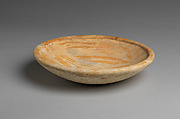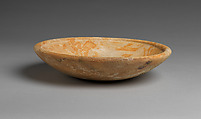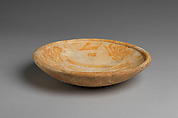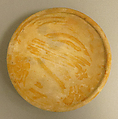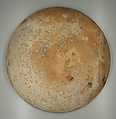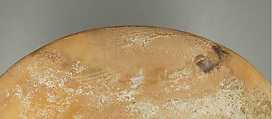On loan to The Met The Met accepts temporary loans of art both for short-term exhibitions and for long-term display in its galleries.
Marble bowl
Technical analysis: Ultraviolet-induced visible luminescence examination, X-ray radiography, optical microscopy, X-ray fluorescence spectroscopy
This bowl, carved from white marble, has notable areas of damage along the rim that have been repaired. Two sections of marble appear to have been reattached with a modern resin, with minor losses filled along the outer edge of the rim. Although the repairs are not discernable on the interior, there is visible discoloration along the join lines on the exterior. The interior of the vessel features unusual streaks of orange, while over half of the exterior is covered with a thick white accretion. The patina of the orange discolorations on the inside, which is gypsum-rich and has high iron, copper, zinc, and arsenic contents, suggests that it might be the result of a chemical treatment. This surface patina is similar to that of the marble female figure L.2022.38.109 and the large marble head L.2022.38.107. No pigment was detected on the surface.
The walls of the vessel rise from a flat base and gently curve out to form a shallow bowl with a with a thickened, rolled rim that would have prevented liquids from spilling. This type of bowl was an especially popular shape in the Early Cycladic II period.
Alexis Belis, Federico Carò, and J-F de Lapérouse
This image cannot be enlarged, viewed at full screen, or downloaded.
This artwork is meant to be viewed from right to left. Scroll left to view more.
